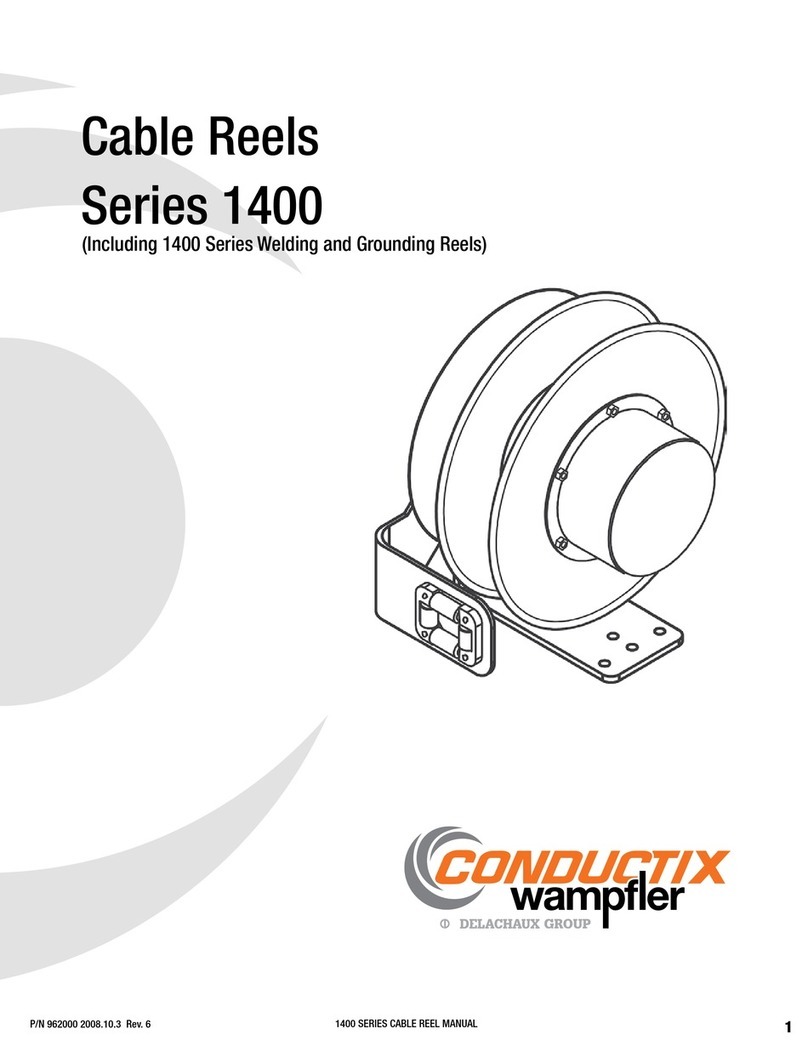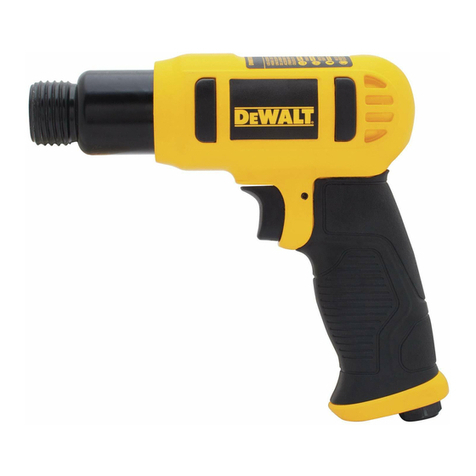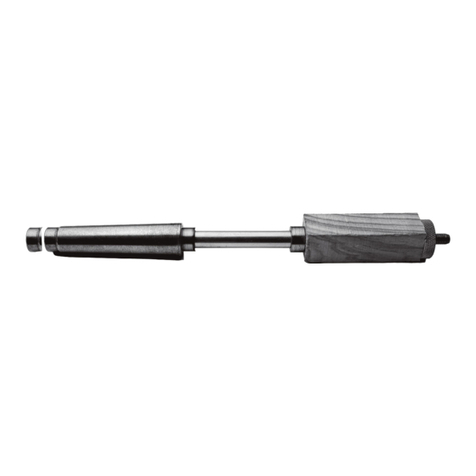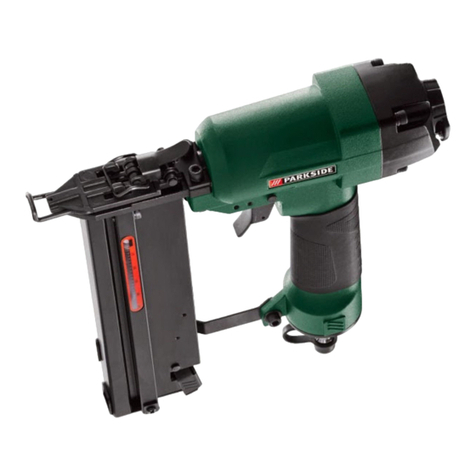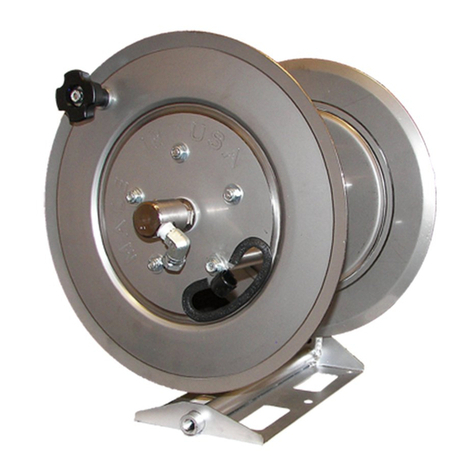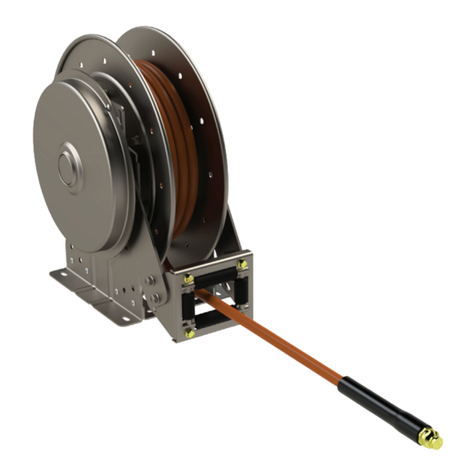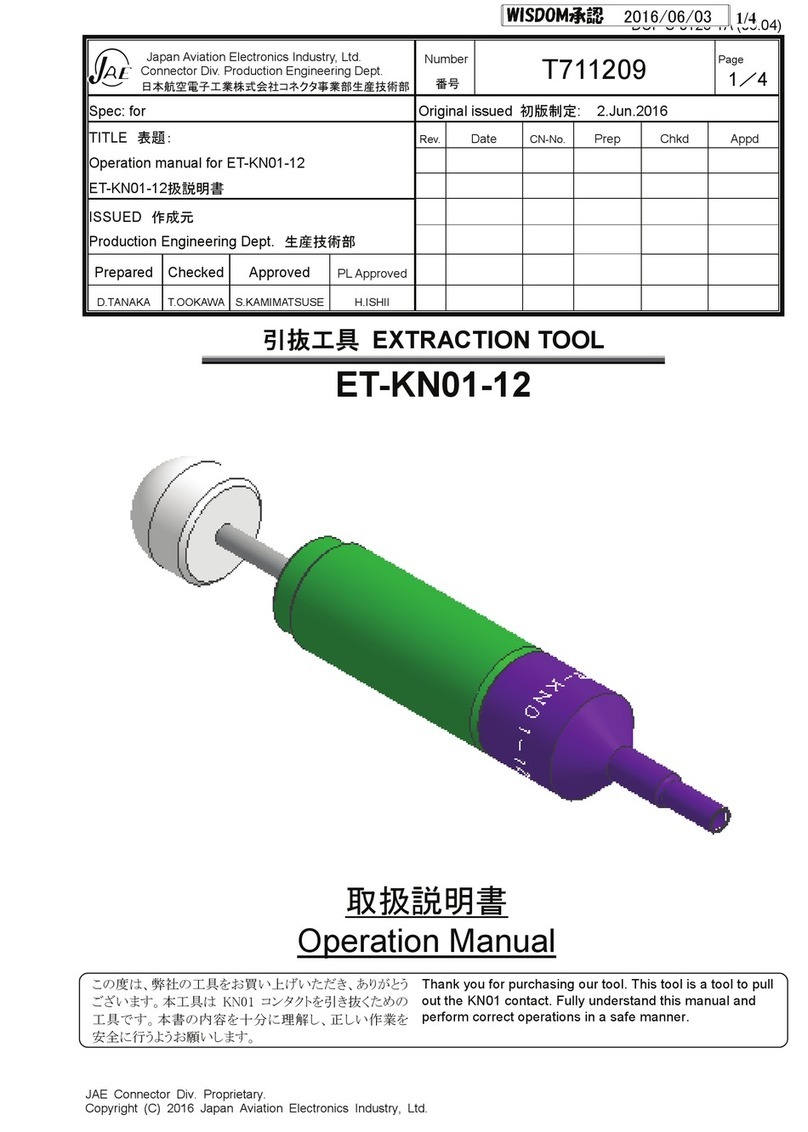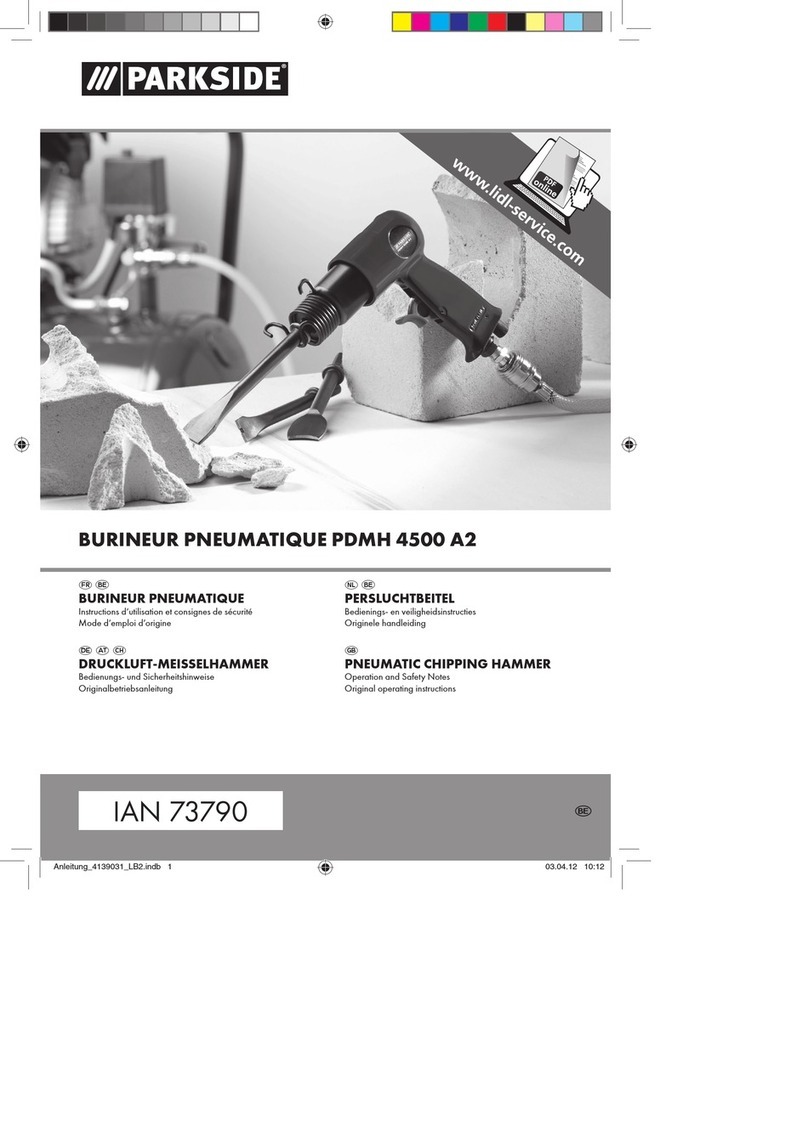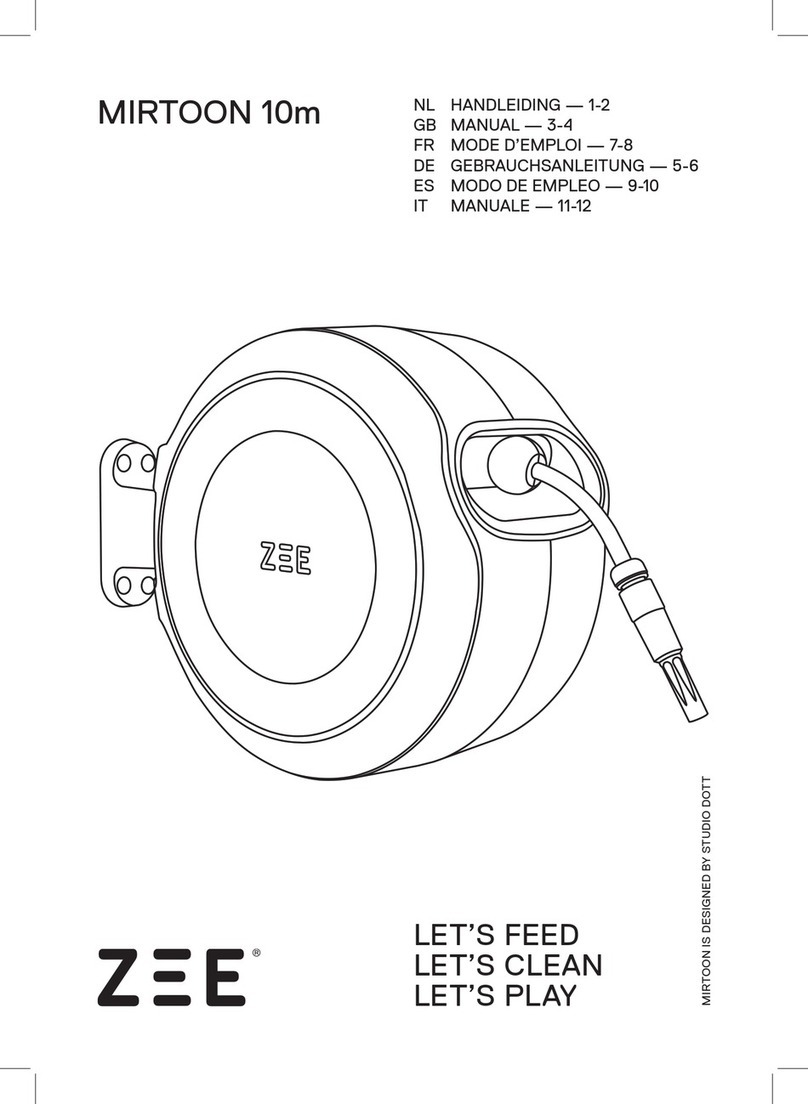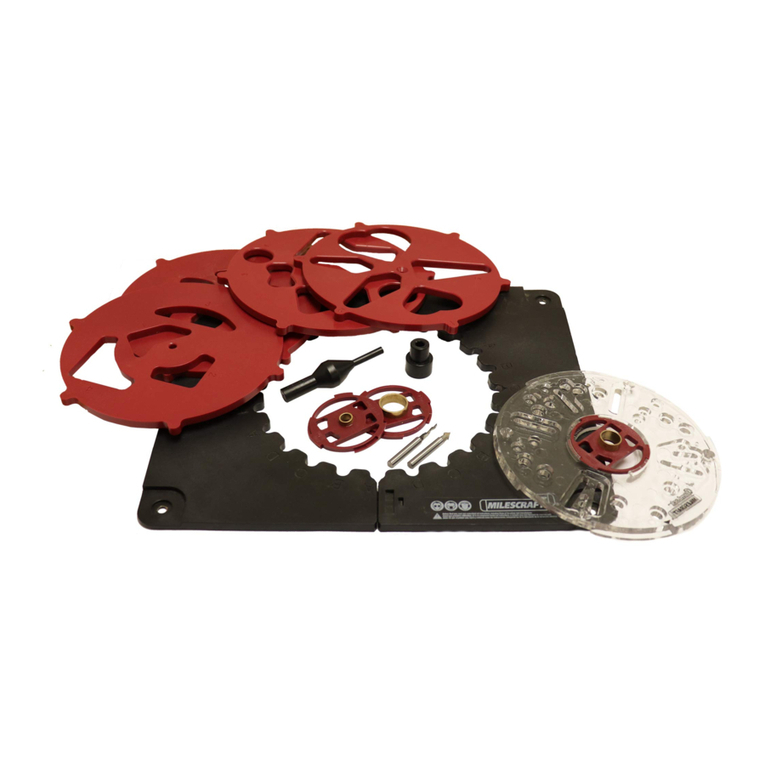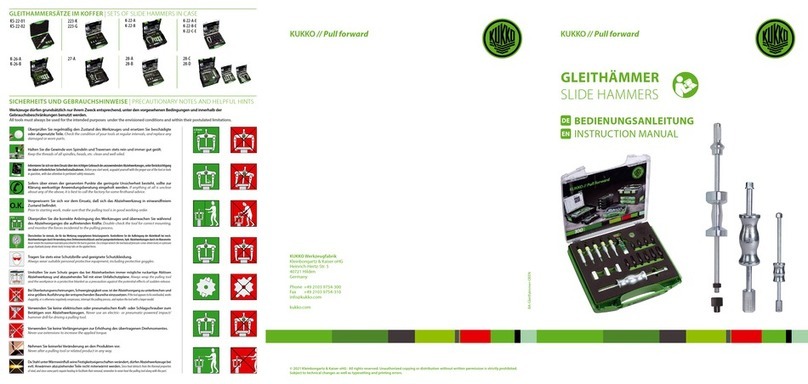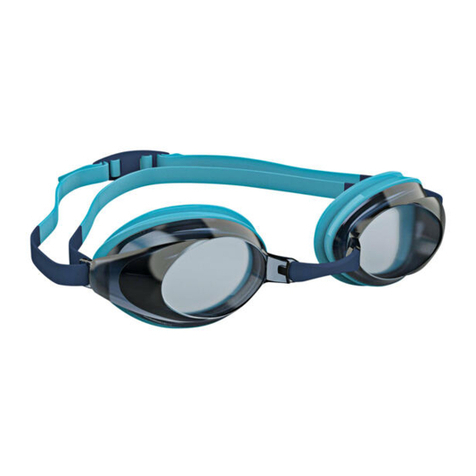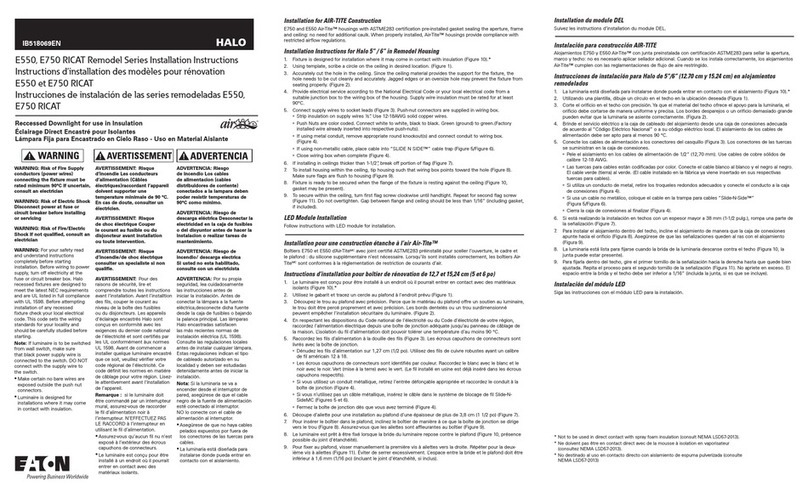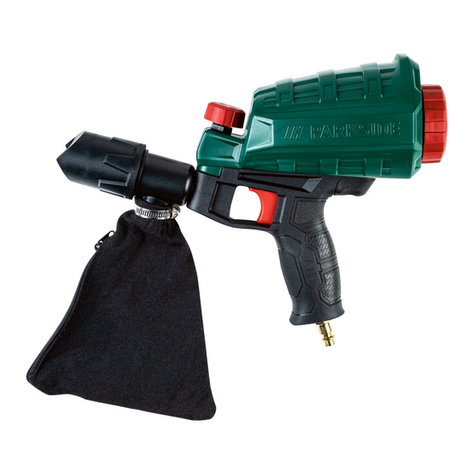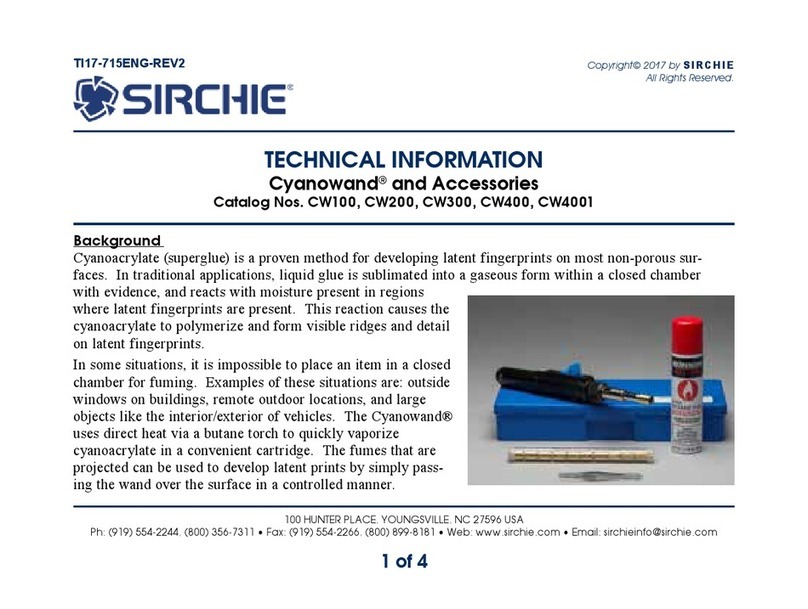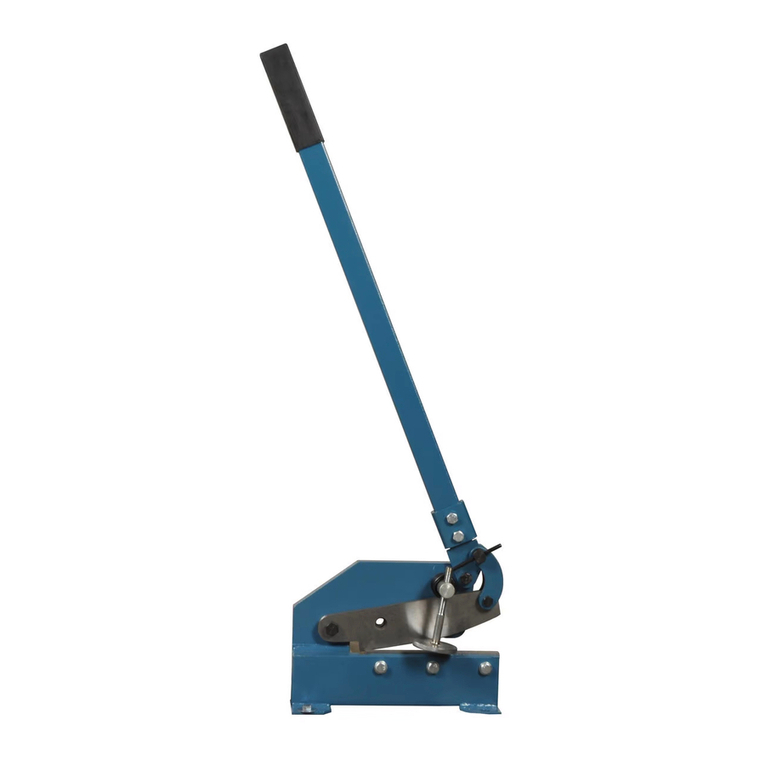Delachaux Conductix-Wampfler 1900 Series User manual

1
IOM 1900 / 2400 DUAL HOSE REEL MANUAL
P/N 962101 2008.10.24 Rev. 2
Dual Hose Reel
Series 1900 / 2400

2IOM 1900 / 2400 DUAL HOSE REEL MANUAL P/N 962101 2008.10.24 Rev. 2
The technical data and images which appear in this manual are for informational purposes only. NO WARRANTIES, EXPRESS OR IMPLIED, INCLUDING
WARRANTIES OF MERCHANTABILITY OR FITNESS FOR A PARTICULAR PURPOSE, ARE CREATED BY THE DESCRIPTIONS AND DEPICTIONS OF THE
PRODUCTS SHOWN IN THIS MANUAL. Conductix makes no warranty (and assumes no liability) as to function of equipment or operation of systems
built according to customer design or of the ability of any of its products to interface, operate or function with any portions of customer systems not
provided by Conductix.
Seller agrees to repair or exchange the goods sold hereunder necessitated by reason of defective workmanship and material discovered and reported to
Seller within one year after shipment of such goods to Buyer.
Except where the nature of the defect is such that it is appropriate, in Seller’s judgment, to effect repairs on site, Seller’s obligation hereunder to remedy
defects shall be limited to repairing or replacing (at Seller’s option) FOB point of original shipment by Seller, any part returned to Seller at the risk and cost
of Buyer. Defective parts replaced by Seller shall become the property of Seller.
Seller shall only be obligated to make such repair or replacement if the goods have been used by Buyer only in service recommended by Seller and
altered only as authorized by Seller. Seller is not responsible for defects which arise from improper installation, neglect, or improper use or from normal
wear and tear.
Additionally, Seller’s obligation shall be limited by the manufacturer’s warranty (and is not further warranted by Seller) for all parts procured from others
according to published data, specifications or performance information not designed by or for Seller.
Seller further agrees to replace or at Seller’s option to provide a refund of the sales price of any goods that do not conform to applicable specifications or
which differ from that agreed to be supplied which non-conformity is discovered and forthwith reported to Seller within thirty (30) days after shipment to
the Buyer. Seller’s obligation to replace or refund the purchase price for non-conforming goods shall arise once Buyer returns such goods FOB point of
original shipment by Seller at the risk and cost of Buyer. Goods replaced by Seller shall become the property of Seller.
There is no guarantee or warranty as to anything made or sold by Seller, or any services performed, except as to title and freedom from encumbrances
and, except as herein expressly stated and particularly, and without limiting the foregoing, there is no guarantee or warranty, express or implied, of
merchantability or of fitness for any particular purpose or against claim of infringement or the like.
Seller makes no warranty (and assumes no liability) as to function of equipment or operation of systems built to Buyer’s design or of the ability of any
goods to interface, operate or function with any portions of Buyer’s system not provided by Seller.
Seller’s liability on any claim, whether in contract, tort (including negligence), or otherwise, for any loss or damage arising out of, connected with, or
resulting from the manufacture, sale, delivery, resale, repair, replacement or use of any products or services shall in no case exceed the price paid
for the product or services or any part thereof which give rise to the claim. In no event shall Seller be liable for consequential, special, incidental or
other damages, nor shall Seller be liable in respect of personal injury or damage to property not the subject matter hereof unless attributable to gross
misconduct of Seller, which shall mean an act or omission by Seller demonstrating reckless disregard of the foreseeable consequences thereof.
Seller is not responsible for incorrect choice of models or where products are used in excess of their rated and recommended capacities and design
functions or under abnormal conditions. Seller assumes no liability for loss of time, damage or injuries to property or persons resulting from the use of
Seller’s products. Buyer shall hold Seller harmless from all liability, claims, suits and expenses in connection with loss or damage resulting from operation
of products or utilization of services, respectively, of Seller and shall defend any suit or action which might arise there from in Buyer’s name - provided
that Seller shall have the right to elect to defend any such suit or action for the account of Buyer. The foregoing shall be the exclusive remedies of the
Buyer and all persons and entitles claiming through the Buyer.
Conductix Incorporated

3
IOM 1900 / 2400 DUAL HOSE REEL MANUAL
P/N 962101 2008.10.24 Rev. 2
1.0 Safety Instructions
1.1 Pressure Warnings
1.2 Operational Warnings
1.3 Maintenance Warnings
1.4 Specifications and Listings
1.5 Pressure and Temperature Rating
1.6 Labels and Markings
2.0 Installation
2.1 Application Types
2.2 Mounting
2.3 Guide Rails
2.4 Roller Guides
2.5 Ratchet
2.6 Hose Installation and Replacement
2.7 Spring Tension Adjustment
3.0 Operation
4.0 Maintenance
4.1 Maintenance Warnings
4.2 Lubrication
4.3 Inspections
4.4 Swivel Joint Assembly Replacement
4.5 Spring Motor Replacement
5.0 Troubleshooting
6.0 Replacement Parts
INDEX

4IOM 1900 / 2400 DUAL HOSE REEL MANUAL P/N 962101 2008.10.24 Rev. 2
Basic Component Identification
Swivel
Reducer Spring
Motor
Frame
Spool
Shaft
Roller
Guide
Spool
Assembly
Reducer
Swivel

5
IOM 1900 / 2400 DUAL HOSE REEL MANUAL
P/N 962101 2008.10.24 Rev. 2
1.0 Safety
1.1 Pressure Warnings
1.1.1 This equipment should be properly installed before use in accordance with local codes and ordinances.
1.1.2 The pressure to the hose reel should be disconnected from the hose reel before any service functions are performed.
1.1.3 This hose reel must not be used for pressure greater than the rating listed on the label. See section 1.5 for Pressure and Temperature ratings.
1.2 Operational Warnings
1.2.1 Exercise care when handling the hose reel during normal operation. This hose reel has a rotating spool powered by springs under tension.
1.2.2 Do not use hose different from that for which the reel is intended. Changes in diameter, weight per foot, length of hose or flexibility will affect the
operation of the reel.
1.2.3 Mounting hardware and fasteners should be installed to maintain tightness under vibration and checked periodically to ensure tightness.
1.2.4 Overhead installation mountings should be such that the reel is not supported by bolts in tension. A safety chain or cable is strongly recommended
to minimize damage and/or possible injury in the event of mounting failure.
1.3 Maintenance Warnings
1.3.1 WARNING: Modification of this equipment may cause excessive wear and will void the warranty. Contact the manufacturer regarding changes or
modifications of equipment which could affect reliability or safety.
1.3.2 DO NOT DISASSEMBLE THE SPRING MOTOR FOR ANY REASON. Serious personal injury could result. This hose reel is equipped with springs
under tension. Contact the factory for assistance.
US: 1-800-521-4888
Canada: 1-800-667-2487
1.4 Specifications & Listings
1.4.1 1900 / 2400 Series Hose Reel products are not certified or listed by any independent certifying or regulatory body.
1.4.2 The following specifications apply to all 1900 / 2400 Series Hose Reels:
1.4.2.1 1900 / 2400 Series Hose Reels are intended for industrial use and are provided with permanent mounting means.
1.4.2.2 1900 / 2400 Series Hose Reel Spring Motors are weather-tight and self-contained.
1.5 Pressure & Temperature Rating
1.5.1 All Insul-8 1900 / 2400 Series Hose Reels without hose installed are rated at 5000 P.S.I. Reels should not be used at pressures greater than
the rating of the hose.
1.5.2 Installed hose is suitable for delivery of specified fluids only.
1.5.3 The operational rating of a reel not equipped with hose is determined by the capacity of the installed hose. The pressure rating of the reel
without hose must not be greater than 5000 P.S.I. Variations in the OD of higher rated hose will affect the operational capacity of the reel.
1.6 Labels & Marking
1.6.1 Hose reels with and without hose
1.6.1.1 The marking of the hose reel provided with or without hose includes the following:
1.6.1.1.1 The label on the frame includes the Conductix-Wampfler name and logo, the product catalog number, PSI rating, description of the reel
and what type and length of hose intended for use on the reel.
1.6.1.1.2 The maximum pressure rating for every hose reel supplied without hose is marked on the Conductix-Wampfler Identification Label.
Actual rating is determined by the installed hose and is not to exceed the indicated maximum rating. The pressure rating of the hose
installed on reels provided without hose must be marked on the label upon installation.

6IOM 1900 / 2400 DUAL HOSE REEL MANUAL P/N 962101 2008.10.24 Rev. 2
2.0 Installation
2.1 Application Types
2.1.1 Stretch Applications
2.1.1.1 The hose is suspended without any intermediate support.
Stretch reels generally require a line pull equal to two times the
weight of the hose with fluid, which allows approximately 10%
sag at full extension. On long applications where sag cannot be
tolerated, it is sometimes desirable to put supports at intervals
of 5 to 10 feet.
2.1.2 Lift Applications
2.1.2.1 The hose is lifted vertically in lift
applications. The reel is normally designed
to handle only the total weight of the hose
with fluid. Some lift applications may
require ball stops to control the length of
hose to be retracted.
2.1.3 Drag Applications
2.1.3.1 The reel is mounted on a stationary object and is required
to drag the hose over the surface to the reel. The hose is
supported by the ground or some type of hose tray.
2.1.4 Retrieve Applications
2.1.4.1 The reel is mounted on the moving object and winds up or pays
out the hose as the machine approaches or moves away from
the fixed end. Retrieve applications can be elevated 4 feet from
the hose support surface.
SUSPENDED SUPPORTED
4’ MAX
MOBILE
FIXED

7
IOM 1900 / 2400 DUAL HOSE REEL MANUAL
P/N 962101 2008.10.24 Rev. 2
2.0 Installation
2.2.1 Standard Mounting
2.2.1.1 The reel is mounted by bolting the base to any flat surface which is structurally sound enough
to support it and the forces of winding and unwinding the hose.
2.2.1.2 The spool drum must rotate on a horizontal axis. Use a level to confirm this.
2.2.1.3 The reel should be oriented so that the hose extends perpendicular to the rotation of
the spool. The total hose deflection should not exceed 15Oto either side of the guide.
Installations without a roller guide have no tolerance for deflection.
2.2.1.4 If deflection is constant to either side of the reel and operation is impaired, re-mount the
reel.
2.2.1.5 A Pivot Base should be used if the angle of deflection is not constant and exceeds 15Oto
either side. Otherwise, excessive hose wear and unreliable operation will result.
2.2.1.6 A safety chain should be used for all overhead installations.
2.2.2 Pivot Base Mounting
2.2.2.1 All 1900 & 2400 Series Dual Hose Reels can be furnished
with an optional pivot base to allow the reel to rotate and
keep the extended hose perpendicular to the application.
See table below for appropriate selection.
2.2.2.2 Pivot bases rotate up to 345O.
2.2.2.3 A Pivot base is required in carousel or loop-track
applications.
2.2.2.4 When a pivot base is used, the reel must be mounted
horizontally (“ceiling” or “floor” mounted).
2.2.2.5 The roller guide should be mounted to require the hose to
travel perpendicular to the axis of pivot base rotation. This
will guard against hose twisting and ensure effective swivel
action from the pivot base.
Spool Width
5.0
8.0
Pivot Base
40274A
40274C
Hose Deflection with Guide.
30O
2.2 Mounting

8IOM 1900 / 2400 DUAL HOSE REEL MANUAL P/N 962101 2008.10.24 Rev. 2
2.0 Installation
2.3 Guide Rails
2.3.1 The optional guide rails can be installed on any of the 1900 & 2400
Series Dual Hose Reels.
2.3.2 Guide Rails provide a barrier between the hose and rotating spool
flange rim. They also act as a safety barrier for installations where
human contact with the rotating spool flange is likely to occur.
2.3.3 Guide Rails provide additional assurance that the hose will wrap
efficiently on the spool for applications involving rigorous motion.
2.3.4 Guide Rails can act as a substitute for the roller guide in applications
that require a two-way pay-out.
2.3.5 Guide Rail Installation
2.3.5.1 Guide Rails are mounted to the base using the holes on the
side edges of the base.
2.4 Roller Guides
2.4.1 All 1900 / 2400 Dual Hose Reel units are equipped with a roller guide.
The guide’s function is to center the hose on the spool and to help the
reel wrap the hose more evenly.
2.4.2 The guide must be located and secured prior to making any hose
connections.
2.4.3 The hose should not bear against either of the spool flanges during
winding as this will tend to inhibit level winding of the hose.
2.4.4 The guide should be secured at the best of two possible positions so
that a minimum change of direction occurs at the guide; otherwise,
hose life will be reduced and reel operation will be impaired.
2.4.4.1 Mount the guide to the reel between the inside edge of the
frame and the spool. Using the two longer motor mount bolts in the
required holes, place the guide arm in position so the cable pays
horizontally off the top of the spool or vertically towards the top of the
spool.

9
IOM 1900 / 2400 DUAL HOSE REEL MANUAL
P/N 962101 2008.10.24 Rev. 2
2.0 Installation
2.5 Ratchet
2.5.1 The ratchet option allows the extended hose to be pulled out and held from retraction by spring tension; generally appropriate for operator
attended applications.
2.5.2 The ratchet for the 1900 & 2400 Series Hose Reels is spring loaded. It is designed to function in all acceptable mounting configurations.
2.5.3 The ratchet option can be installed at the time of purchased or later added to reels that have already been introduced to service.
2.5.4 Ratchet Option Installation
2.5.4.1 WARNING: Fluid Pressure should be disconnected from the reel before beginning any service or maintenance functions. Follow lock-
out/ tag-out procedures appropriate to the facility.
2.5.4.2 Ratchet Pawl Installation
2.5.4.2.1 The ratchet pawl assembly is attached to the reel frame as
a unit. The holes provided for the attachment of the ratchet
pawl assembly are located in the lower middle of the frame.
2.5.4.2.2 Insert the (2) 3/8 -16x1” bolts (provided) in the frame.
2.5.4.2.3 Position the ratchet pawl assembly over the protruding bolt
shafts.
2.5.4.2.4 Secure using the (2) sets of 3/8-16 hex nuts & lockwashers
provided.
2.5.4.3 Ratchet Plate Installation
2.5.4.3.1 Loosen the (2) 1/4-20 setscrews on the spool hub with a
1/8” allen wrench and adjust spool so that the ratchet pawl
pin clears the spool by 0.030” to 0.125”.
2.5.4.3.2 Locate the four (4) bolt holes in the inside spool flange for
the ratchet teeth. These will be arranged in two sets of
two, 180 degrees from each other.
2.5.4.3.3 Mount the ratchet teeth in one of these sets of holes
oriented as in the figure below. Be sure to install the
provided bolts from inside the spool so that the nuts are on
the outside of the spool and will not rub on the hose.
2.5.4.3.4 A second set of ratchet teeth can be added to the second
set of holes if desired to provide more frequent locking
positions.

10 IOM 1900 / 2400 DUAL HOSE REEL MANUAL P/N 962101 2008.10.24 Rev. 2
2.0 Installation
2.6 Hose Installation Warnings
2.6.1 Hose Installation Warnings
2.6.1.1 If an existing hose is being replaced, remove the old hose. Replacement hose should be the same size and length and pressure rating
as the existing hose. Any variations to existing hose specifications should be pre-approved by the factory.
2.6.1.2 Variations in inner and outer hose diameters will significantly impact reel performance. Factory specifications should be matched as
closely as possible. Contact Conductix-Wampfler Sales for further information.
2.6.1.3 Shut-off and relieve the fluid or air pressure to the reel before attempting to disconnect the hose. Disconnect all pressure as per Lock-
out/Tag-out procedures outlined in OSHA section 1910.147.
2.6.2 Hose Removal
2.6.2.1 Disconnect supply pressure from the reel and carefully drain pressure from hoses.
2.6.2.2 Remove ball stop and all the spring tension on the reel. Make sure that the hose ends are through the roller guide arm and back on the
hose drum.
2.6.2.3 Remove the roller guide head from the guide arm.
2.6.2.4 Remove the hoses from the drum by looping the hoses over the flange without turning the spool.
2.6.2.5 Remove the swivel on the outer side of the spool from the reel shaft.
2.6.2.6 Remove the two (2) clamps that hold the hoses to the drum.
2.6.2.7 Remove the five (5) 1/4-20 nuts from the outer flange and slide the flange off the edge of the shaft.
2.6.2.8 Slide the drum off the remaining drum bolts.
2.6.2.9 Unscrew hose fittings from shaft assemblies. If hoses were not supplied with swivel ends, it will be necessary to cut banding from hoses
to allow hose to rotate independent from each other.
2.6.3 Hose Installation
2.6.3.1 Prepare the hose to be loaded onto the reel. Support the hose, or lay the full length of hose out in the direction of travel. Make sure the
hose will lay flat by removing any twist from the hose.
2.6.3.2 Apply pipe joint compound to all NPT connections and connect the hose to the shaft or elbow assemblies as required to avoid kinking
the hose when wound on the shaft.
2.6.3.3 Slide the cable drum onto the five (5) drum bolts guiding the two on either side of the drum entrance through the tubing.
2.6.3.4 Slide the outer flange on the shaft and insert the drum bolts into the bolt holes.
2.6.3.5 Install the (5) 1/4-20 nuts on the drum bolts and tighten.
2.6.3.6 Install cable clamps on cable by bolting through the two holes in the drum. Make sure the clamps are the right size to hold tightly
around the hose.
2.6.3.7 Band the two hoses together by an acceptable method for your hose type and application. Bands should not be placed more than two
feet (2’) apart. This step is not required for bonded dual hoses such as oxygen/acetylene hose.
2.6.3.8 Wind the hose onto the reel by turning the spool manually in a counter clockwise direction when viewed from the spool side. (Custom
left hand reels are reversed.)
2.6.3.9 Reinstall the roller guide and outer swivel and adjust set-up turns as required.
2.6.4 Hose Pressurization
2.6.4.1 Verify all connections before pressurizing the hose reel.
2.6.4.2 Fully extend the hose before pressurizing the line. The hose will tend to expand and may become wedged between the flanges.
2.6.4.3 Inspect both the reel and the hose for leaks (using soap & water for all gas applications) at the joints after initial pressurization.

11
IOM 1900 / 2400 DUAL HOSE REEL MANUAL
P/N 962101 2008.10.24 Rev. 2
2.0 Installation
2.7 Spring Tension Adjustment
2.7.1 Spring Tension Warnings
2.7.1.1 The adjustment may require mechanical assistance in more demanding applications and installations.
2.7.1.2 WARNING: Do not allow hose to retract without restraining the retraction speed. Walk the hose back to the reel during the spring tension
adjustment process.
2.7.2 Spring Pre-Tensioning
2.7.2.1 The proper pre-tensioning required for effective operation varies by hose diameter and hose weight. Trial and error is the most effective
means of setting the proper spring pre-tension. Pre-tensioning is achieved by pre-loading the spring with setup turns (reel revolutions).
2.7.2.2 Relieve the reel of all spring tension before putting on setup turns. Grasp the end of the hose and the spool and rotate both spool and
hose together in the payout direction until you feel the spring catch engage and the spring tension starts.
2.7.2.3 Initially start with (2) set-up turns, Adjust according to section 2.7.3
2.7.2.4 Feed the end of the hose through the roller guide (if present) and test the Spring Tension. Pull the hose out the required distance and
allow it to rewind.
2.7.3 Adjusting Spring Tension
2.7.3.1 Additional setup turns may be added. One setup turn can be removed if the torque tension is too high.
2.7.3.2 Do not add or remove setup turns on the reel after the hose has been terminated. The resulting twist may kink the hose and shorten
hose life.
2.7.3.3 Disconnect the terminated end of the hose and/or remove the ball stop if applicable.
2.7.3.4 Add one wrap of hose to the spool by pulling the end of the hose through the roller guide and winding the hose around the spool. The
hose should then be fed back through the roller guide.
2.7.3.5 Relocate the ball stop if applicable.
2.7.4 Spring Cycling
2.7.4.1 The spring should be cycled after mounting but before terminating the free end. This will verify the tension adjustment and assure that
the hose will retract properly.
2.7.4.2 Spring cycling is accomplished by pulling the hose out the required distance and walking it back to the retracted position while counting
the number of complete rotations made by the reel. The number of rotations should not exceed the maximum number for the given
spring as indicated in the following table. This procedure should be performed five to ten (5-10) times.
Maximum Spring Turns
Spring Motor Number of Turns
E, EP, F, FP 15
L, LP 22
ES, ES 30
LS 44

12 IOM 1900 / 2400 DUAL HOSE REEL MANUAL P/N 962101 2008.10.24 Rev. 2
3.0 Operation
3.1 Do not exceed the pressure or temperature rating of the hose. Do not exceed the pressure or temperature rating of the reel. Pressure and
temperature above the rated capacity could cause damage to equipment and personal injury could result.
3.2 Operate the reel within the hose size, length and spring tension limits for which it was intended.
3.2.1 Note: Two wraps of hose should remain on the reel at maximum extension to avoid excessive tension on the hose clamps.
3.2.2 The spring should not be wound to the last two turns at maximum payout to avoid over-stressing the spring, thus reducing spring life or
damaging the reel.
3.3 Keep the reel and hose clean to avoid excessive wear and damage.
3.4 Arrange for maintenance service if damage is found on the hose or reel.
3.5 Hose should be fully retracted when not in service to maximize spring life.
4.0 Maintenance
4.1 Maintenance Warnings
4.1.1 Be sure all pressure is off for maintenance.
4.1.2 Follow lock-out/tag-out procedures as outlined in OSHA section 1910.147 where appropriate.
4.2 Lubrication
4.2.1 All springs and bearings are lubricated for life at the factory. Additional lubrication should not be required.
4.2.2 Do not apply any lubricants or solvent cleaning agents to the swivel joint.
4.3 Inspections
4.3.1 Periodically check the reel for any loose or missing fasteners. Tighten or replace as necessary.
4.3.2 The swivel joint assembly should be checked periodically for leakage.
4.3.3 Inspect hose for damage or wear which would make it unsafe to use.
4.4 Swivel Joint Assembly Replacement
4.4.1 The swivel joint should be replaced, not rebuilt, if it becomes damaged.
4.4.2 Turn off supply pressure and carefully drain hoses of all pressure.
4.4.3 Unscrew supply lines from swivel to be replaced.
4.4.4 Unscrew swivel from end of reel shaft and dispose of the damaged swivel.
4.4.5 Apply pipe joint compound to threads of new swivel.
4.4.6 Screw new swivel into end of reel shaft and tighten.
4.4.7 Apply pipe joint compound to threads of supply hose and screw into swivel

13
IOM 1900 / 2400 DUAL HOSE REEL MANUAL
P/N 962101 2008.10.24 Rev. 2
4.0 Maintenance
4.5 Spring Motor Replacement
4.5.1 Spring Motor Warnings
4.5.1.1 CAUTION: Do not open the spring motor or personal injury may result.
4.5.1.2 The spring replacement process is determined by the spring configuration and cannot be performed in the field. The entire spring motor
must be replaced as a unit.
4.5.1.3 For further instructions, consult the factory.
In the USA call: 1-800-521-4888
In Canada call: 1-800-667-2487
4.5.2 Spring Motor Life
4.5.2.1 Spring life is determined by duty cycle and application requirements. Spring life can vary depending on operating environment,
application range, and duty cycle. Actual performance and maintenance scheduling can only be determined by individual factors in the
application.
4.5.3 Spring Motor Removal & Replacement
4.5.3.1 Turn off pressure supply to reel and carefully drain pressure from hoses.
4.5.3.2 Unhook hose ends from external equipment and allow reel to fully retract using care not to let the reel retract in an uncontrolled manner.
4.5.3.3 Unscrew swivel fittings from both ends of the shaft.
4.5.3.4 Unwind hoses off of spool without pulling against spring tension or winding spring.
4.5.3.5 Remove hose clamps from spool drum.
4.5.3.6 Remove the five (5) 1/4-20 nuts from the outer flange and slide flange off the end of the shaft.
4.5.3.7 Slide the spool drum off the bolts.
4.5.3.8 Unscrew hose and fittings from shaft.
4.5.3.9 Remove the two (2) setscrews from aluminum drive hub on inner flange.
4.5.3.10 Slide inner flange off the shaft.
4.5.3.11 Unscrew spool shaft section from motor shaft section.
4.5.3.12 Remove REEL-SAFE sprocket from motor shaft sprocket if so equipped.
4.5.3.13 Remove snap ring from shaft near frame.
4.5.3.14 Remove five (5) 1/4-20 nuts and bolts from around the motor flange. Note: dual spring motors have spacers between motor flange and
frame.
4.5.3.15 Slide motor out of frame bearing.
4.5.3.16 Install new motor in reverse order.

14 IOM 1900 / 2400 DUAL HOSE REEL MANUAL P/N 962101 2008.10.24 Rev. 2
5.0 Troubleshooting
Problem Possible Cause Solution
Reel will not retract hose but has some tension
1) Improper pretension. 1) See tension adjustment Section 2.7
2) Incorrect reel for application (lift vs. stretch). 2) Quantify application vs. reel selection.
3) Improper hose or hose length installed. 3) Install hose for which reel is intended.
4) Roller “hose” guide adjustment. 4) Check guide alignment
5) Ratchet is installed in constant tension
application. 5) Remove Ratchet
Reel does not have spring tension 1) Broken spring (Quantify application to
prevent reoccurrence.) 1) Replace spring.
Reel will not engage 1) Broken ratchet pawl spring. 1) Replace pawl spring.
Reel will not disengage 1) Over-extension of reel.
1) Manually rotate reel spool to disengage
ratchet. Do not overextend or adjust guide
to prevent lockup when reel is overextended.
2) Readjust ball stop if applicable.
Hose improperly wraps on reel (wraps above or
jumps flange).
1) Improper hose or hose length installed 1) Install hose for which reel was intended.
2) Hose guide adjustment 2) Check & adjust guide alignment.
Hose twisting or knotting.
1) Improperly installed hose. 1) See hose installation section of IOM)
2) Hose rubbing on or bending around fixed
object.
2) Check roller guide for function and hose pay
out path.
3) Excessive spring tension. 3) Quantify application vs. reel selection.
4) Inadequate anchoring of hose. 4) Adjust anchoring method. i.e. add strain
relief (kelloms grip).
System leaks, looses or does not transfer fluids/
gas.
1) Faulty hose or connections.
Inspect and repair or replace
2) Worn swivel joint

15
IOM 1900 / 2400 DUAL HOSE REEL MANUAL
P/N 962101 2008.10.24 Rev. 2
1900 / 2400 Dual Hose Reel Parts View
1
6F
6D
6B
6A
5
4
3 A & B
2
1
1B
1A
3
6C
6E
1B
1A

16 IOM 1900 / 2400 DUAL HOSE REEL MANUAL P/N 962101 2008.10.24 Rev. 2
6.0 Replacement Parts
P E ES H62
3
Assy
42962
42963
3A
Bearing Housing
40220
40220
3B
Bearing
E23
E23
Discriptive Digit
#2
E&F
G, H, J, K, L & M
Frame Assembly
42934
42935
E&F
G, H, J, K, L & M
Guide Arm
4
40258D
40257D
E&F
G, H, J, K, L & M
Guide Head
5
42944
42945
42946
42947
42948
42949
42950
42951
42952
L
LS
LP
E
ES
EP
F
FS
FP
Spring Motor Assembly
2Q
1
Assy
43870
43871
43872
1A
Swivel
E614-.25
E614-.375
E614-.500
1B
Reducer
05918
05906
05917
4
6
8
Swivel Kit
1/4”
3/8”
1/2”
6F
Grommet
102296
102296
102296
102296
102296
102296
102296
102296
6E
Outer Flange
42937
42937
42939
42939
42939
42939
42939
42939
6C
Drive Hub
S390-8048-TK
S390-8048-TK
S390-8048-TK
S390-8048-TK
S390-8048-TK
S390-8048-TK
S390-8048-TK
S390-8048-TK
6
Assy
42953
42954
42955
C/F
C/F
42956
C/F
C/F
6A
Shaft
42933
42933 + 42961
42933
42933
42933
42933 + 42961
42933 + 42961
42933 + 42961
6B
Inner Flange
42936
42936
42938
42938
42938
42938
42938
42938
Discriptive
Digit #2
E
F
G
H
J
K
L
M
Spool
6D
Drum
42940
42941
42940
C/F
C/F
42941
C/F
C/F
40212A
40212AA
40212B
40212BB
E
F
G, H & J
K, L &M
Guide Rails (Option)
40274A
40274C
E, G, H & J
F, K, L & M
Pivot Base (option)
40251A
Ratchet (Option)
40260A
Spool Lock
(Option)
(Q) Recommended Spare Part
Swivel Kit
Catalog # Description # Part #
1-3 4 43874
1-3 6 43875
1-3 8 43876
4 (Oxy/Ace) 6 43873
5 #F C/F

17
IOM 1900 / 2400 DUAL HOSE REEL MANUAL
P/N 962101 2008.10.24 Rev. 2
Notes

18 IOM 1900 / 2400 DUAL HOSE REEL MANUAL P/N 962101 2008.10.24 Rev. 2
Notes

19
IOM 1900 / 2400 DUAL HOSE REEL MANUAL
P/N 962101 2008.10.24 Rev. 2
Notes

20 MANUAL NAME P/N 962101 2008.10.24 Rev. 2
www.conductix.com
Conductix-Wampfler
10102 F Street
Omaha, NE 68127
USA
Customer Support
Phone: 800 521 4888
Fax: 800 780 8329
Phone: 402 339 9300
Fax: 402 339 9627
www.conductix.com
This manual suits for next models
1
Table of contents
Other Delachaux Tools manuals
